How to determine gas flow: methods for measuring and calculating the fuel used
One way or another, you came across the issue of saving and power of household appliances. Be it during the first repair phase or when replacing obsolete equipment. It can be useful to calculate the gas flow rate or the need for it before buying a stove or boiler, choosing a gas meter, and possibly replacing it. If you have questions about gas charges, if the search for new equipment is a matter for you in the coming weeks, the exact method of determining gas consumption and the calculation formula will make your life easier.
Gas prices are gradually rising, and appliances are becoming more powerful, so it will not hurt you to come up with your own strategy for optimizing costs. Our article will help you with this. You cannot find out about the current level of gas consumption in your housing from conversations with neighbors; you need accurate information.
The content of the article:
Natural gas consumption at home
The owners of all apartments and houses, many enterprises need to calculate the volume of gas consumed. Data on the need for fuel resources are included in the projects of individual houses and their parts. To pay by actual numbers, use gas meters.
The level of consumption depends on the equipment, thermal insulation of the building, season. In apartments without central heating and hot water supply, the load goes to a water boiler. The device consumes up to 3-8 times more gas than a stove.
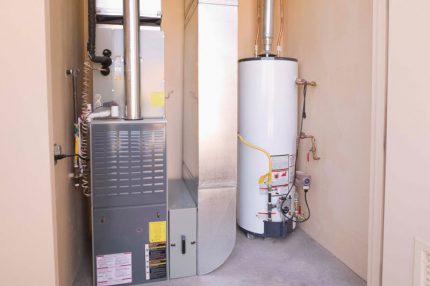
The maximum consumption of the stove depends on the number of burners and the power of each of them:
- lowered - less than 0.6 kW;
- ordinary - about 1.7 kW;
- increased - more than 2.6 kW.
According to another classification, the low power of the burners corresponds to 0.21-1.05 kW, normal - 1.05-2.09, increased - 2.09-3.14, and high - more than 3.14 kW.
A typical modern stove uses at least 40 liters of gas per hour when turned on.Typically, the stove spends about 4 m³ per month for 1 tenant, and the consumer will see about the same figure if he uses a meter. Compressed gas in cylinders in terms of volume requires much less. A family of 3 people with a capacity of 50 liters is enough for about 3 months.
In an apartment with a stove for 4 burners and without a water heater, you can put a G1.6 marking counter. A device with frame size G2.5 is used if there is also a boiler. To measure gas flow, large gas meters are also installed on G4, G6, G10 and G16. A meter with parameter G4 will cope with the calculation of gas consumption by 2 stoves.
Water heaters are 1-and 2-circuit. For a boiler with 2 branches and a powerful gas stove, it makes sense to put 2 counters. One of the reasons is that household gas meters do not cope well with the big difference between the power of the equipment. A weak stove at minimum speed uses many times less fuel than a heater at maximum.

Subscribers without meters pay for the volume, based on consumption per 1 inhabitant multiplied by their number, and consumption per 1 m², multiplied by the heated area. The standards are valid all year round - they laid the average indicator for different periods.
Norm for 1 person:
- Gas consumption for cooking and heating water using a stove in the presence of centralized hot water (DHW) and central heating is about 10 m³ / month per person.
- The use of a stove alone without a boiler, centralized hot water supply and heating is approximately 11 m³ / month per person.
- The use of a stove and a water heater without central heating and hot water is about 23 m³ / month per person.
- Water heating by a water heater is about 13 m³ / month per person.
In different regions, the exact flow rates do not match. Individual heating by means of a water heater costs about 7 m³ / m² for heated residential premises and about 26 m³ / m² for technical.
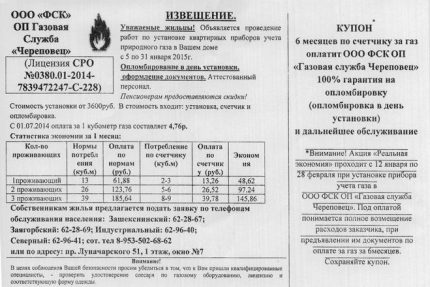
The dependence on gas consumption was indicated in SNiP 2.04.08-87. The proportions and indicators are different there:
- stove, central hot water supply - 660 thousand kcal per person per year;
- there is a stove, no hot water supply - 1100 thousand kcal per person per year;
- there is a stove, a water heater and no hot water supply - 1900 thousand kcal per person per year.
The consumption according to the standards is affected by the area, the number of residents, the level of comfort with household communications, the presence of livestock and its livestock.
The parameters are differentiated based on the year of construction (before 1985 and after), the attraction of energy-saving measures, including insulation of facades and other external walls.
You can read more about gas consumption per person in this stuffe.
Calculation of gas for heating, hot water, stove
The required amount of fuel for space heating is recognized by the quadrature or cubic capacity of the room. In the case of rooms of 3 meters in height and less, it is enough to determine the area. For 1 square. a meter of such premises on average will need 100 watts.
In the southern regions of the country, the specific parameter per 1 m² is reduced to 80 W, in the extreme north it is increased to 200 W per m². The water heater is selected with a margin above the maximum load.
With the volumetric method of counting per cubic meter, 30 to 40 W are diverted, with a decrease in the number for the southern regions. All methods work well in the winter, but they decrease by 1 m² as the difference between the external temperature and the room temperature drops from 40 degrees to 10.
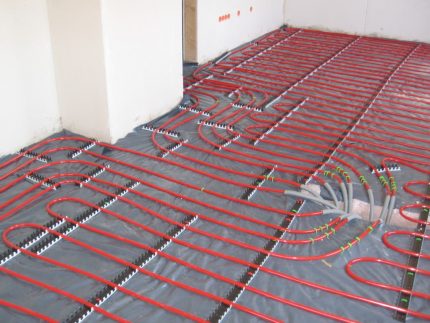
The maximum gas flow rate of the boiler is calculated by the formula V = Q / (q × Efficiency / 100)where:
- V - fuel volume, m³;
- Q - power of the heating system and heat loss, kW;
- q - the lowest specific calorific value of fuel, kW / m³ (average 9.2);
- Efficiency - the efficiency of a gas boiler, usually 96%.
Using the same, but modified formula, you can calculate the maximum consumption of the stove, including per unit of time.
When measuring the flow rate of liquefied gas (LHG), instead of the lowest specific calorific value, the specific heat of combustion is substituted. It is different for different mixtures, and for propane-butane it is 46 MJ per kg. The efficiency of a gas boiler when using LPG is reduced from 96 to 88%.
The amount of fuel for an individual hot water supply is determined by the needs of 1 person. Information is in the documentation for water consumption, but the calculation can be done independently. For a family of 4, 1 heating of 80 liters per day is enough, from +10 to +75 ° C.
The required power is determined by the formula Q = c × m × Δt, wherein:
- Q - in fact, the required power, in kW;
- c is the heat capacity of water, 4,183 kJ / kg × ° C;
- m is the flow rate of water, kg;
- Δt is the difference between the initial and final temperatures, usually 65 ° C.
Save on fuel through system and external methods. Condensing stoves, indirect heating boilers with a timer give benefits. Automation will help with a change in temperature in the room from comfortable for a person to + 10 ... + 15 ° C for the time of absence. External savings options include home insulation and underfloor heating.
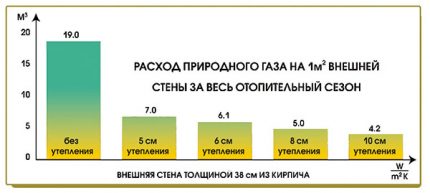
You can save gas when using the stove in the following ways:
- “Do not let out” the flame from under the bottom of the containers;
- close kettles and pans with lids;
- to boil use only maximum heat;
- warm food in large portions.
The gas flow rate is also determined before roofing, in the burners for surfacing. A 50-liter cylinder with a mixture of propane-air will last for 10.8 hours, because the consumption will be approximately 2 kg / hour. For 1 m² of coverage, 0.2 kg in spring - autumn and 0.3-0.4 kg in winter will be required.
We also suggest reading our other articles, where we spoke in detail about how to correctly calculate the gas consumption for heating a house:
Meters for measuring fuel consumption
The meter measures the amount of gas at different conditions of temperature and pressure, and with the presence of special equipment, it leads the result to an indicator that will be under standard conditions (CS) - +20 ° C and 101 kPa.
The fuel volume for SU is determined by the formula Vc = V × (p × Tc / pc × T × K)where
- V is the volume of gas;
- p is the density;
- T is the thermodynamic temperature;
- K is the compressibility factor of the fuel.
Values with the letter "c" are indicators for standard conditions, without - for workers.
In everyday life, membrane, rotational and ultrasonic meters are used; at large enterprises, turbine and vortex meters are the most popular types of gas meters. In gas industry plants, volume is determined mainly by variable pressure changes in the constrictions, often between 2 flange joints in the immediate vicinity. Counters differ in working features.
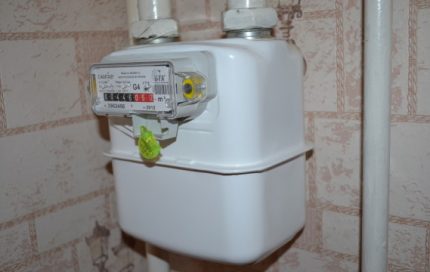
Diaphragm flow meters give the minimum error in the calculations and consume little electricity. The devices give readings in a wide range, but with a low ultimate pressure - up to 0.5 bar. In everyday life, the meter shows itself in the best way, since the calibration interval reaches 10 years with high reliability of the device. The design does not respond well to mechanical gas pollution and is generally cumbersome.
Rotary or rotary, models are independent of the power grid, suitable for small industrial facilities, but they are less convenient.With a small installation area and high accuracy in conditions of sharp pressure drops, they make noise and more often fail. They are “afraid” of pneumatic impacts and pollution.
Ultrasonic Counters have a small size, vary greatly in complexity of the structure. Acoustic gas meters are appreciated for their reliability and ease of installation. Some devices contain non-volatile memory. Counters for sizes G1.6 and G2.5 are relatively expensive.
Turbine devices used to measure the amount of domestic and aggressive gases, multicomponent compositions. Meters are widely used in gas pipelines and chemical plants. Turbine devices record large amounts of gas at pressures up to 10 MPa, and vary significantly in size and working DN. These are universal instruments for measuring the consumption of natural gas in industry.
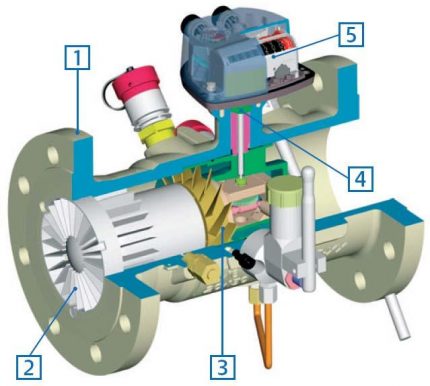
Whirlwind measure the volume of natural or inert gases. They have an advantage over other models in the measurement range. The smallest movements in the gas mixture are detected and large quantities of gas are detected per diameter. The efficiency of the vortex flow meter is directly proportional to the flow rate of the fuel.
Measurement methods used in gas flow meters
Fuel consumption calculated direct and indirect methods.
In the case of direct gas fills the measuring chambers and leaves them. The past volume correlates with filling-emptying cycles. According to the described principle, counting works in membrane, rotary and drum counters.
Gas meters with an indirect method of measurement work with indicators of speed and known cross-sectional area. The method of counting is mechanical or other, related to the features of the meter. In mechanics, turbines, impellers, balancing elements are used.
The indirect method of counting has other methods:
- vortex detection;
- measuring the pressure difference on the constriction device;
- calculation of heat transfer from a heated body;
- velocity head measurement;
- counting based on the movement of ultrasound.
The correctness of indirect techniques depends on the correspondence of speed in direction and cross section. The flow preparation tools help: turbulizers, condensers, and flow rectifiers. Devices go separately or as elements of counters.
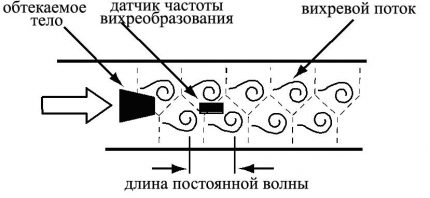
The difference in speed over the cross section of the instrument can be determined simultaneously with the speed of gas movement and thus reduce the error. The latter often occurs due to stagnation of fuel near the walls. Read more about direct and indirect methods for determining gas flow. Further.
How is gas pressure determined?
Pressure is measured directly using manometers or adding up atmospheric (Pb) and gauge pressure (Pи). Pb is measured at the location of the transducer P and if the latter is in a confined space and there is boost or vacuum in it.

The pressure selection hole for vertical and horizontal pipes is placed radially. On the transverse pipeline it is located in the upper half of the section.
In flow meters without the indicated hole, selection is carried out in front of the meter, at a distance of 1 to 3 pipeline diameters, with a reference point from the inlet flange of the gas meter.
Conclusions and useful video on the topic
Estimated gas consumption by the boiler at a certain power:
High gas consumption when using gas balloon equipment for a car:
Simple ways to reduce fuel consumption in an apartment / house:
Time has shown that it is better to have one or several counters in your apartment. Only with large volumes of consumption and the high price of gas meters is it becoming more profitable to pay a standard fee. In domestic conditions, flow meters with rotors and membranes, smart metering, are used to measure gas flow.
For commercial purposes, use turbine, vortex and levitation. For the most accurate measurements in the laboratory, drum models are installed. It is not enough to have a gas meter, sometimes you need to consider it yourself. The estimated amount of gas for current and planned needs should be determined by the formulas or together with an invited specialist.
Write comments on the topic of the article. Tell us if you had to determine the gas flow yourself, and if so, for what purpose did you do it. Ask questions in the form below the article.

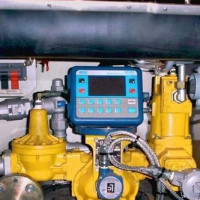 How and in what is gas flow measured: measurement methods + overview of all types of gas flow meters
How and in what is gas flow measured: measurement methods + overview of all types of gas flow meters 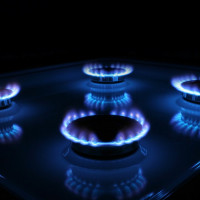 How much gas a gas stove consumes: gas flow calculation procedure
How much gas a gas stove consumes: gas flow calculation procedure 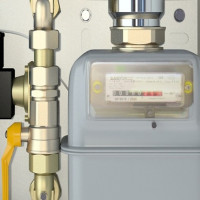 Gas consumption from the gas tank for heating: how to calculate + tips to minimize
Gas consumption from the gas tank for heating: how to calculate + tips to minimize 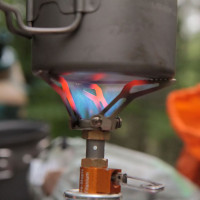 How long is the gas cylinder enough: gas flow calculation for typical gas cylinders
How long is the gas cylinder enough: gas flow calculation for typical gas cylinders  How much does it cost to connect gas to a private house: the price of organizing gas supply
How much does it cost to connect gas to a private house: the price of organizing gas supply 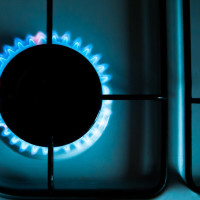 The rate of gas consumption per 1 person per month in a house without a meter: the principle of calculating gas costs
The rate of gas consumption per 1 person per month in a house without a meter: the principle of calculating gas costs  The best washing machines with dryer: model rating and customer tips
The best washing machines with dryer: model rating and customer tips  What is the color temperature of light and the nuances of choosing the temperature of the lamps to suit your needs
What is the color temperature of light and the nuances of choosing the temperature of the lamps to suit your needs  Replacement of a geyser in an apartment: replacement paperwork + basic norms and requirements
Replacement of a geyser in an apartment: replacement paperwork + basic norms and requirements